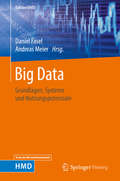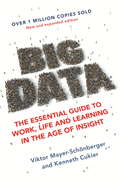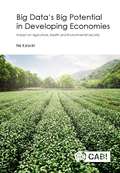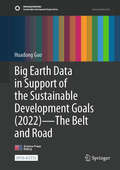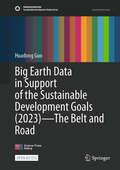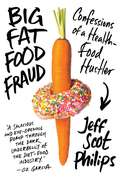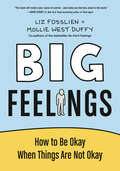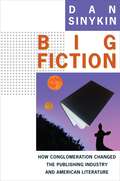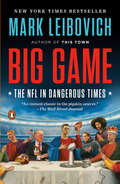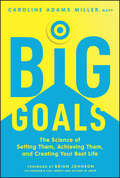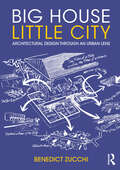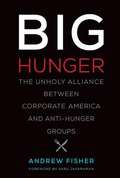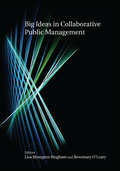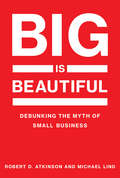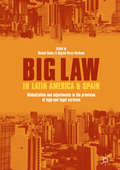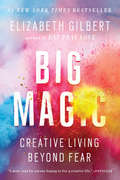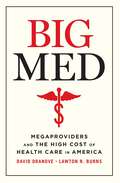- Table View
- List View
Big Data: Grundlagen, Systeme und Nutzungspotenziale (Edition HMD)
by Andreas Meier Daniel FaselDieser Herausgeber-Band bietet eine umfassende Einführung in das Gebiet Big Data. Neben einer Markteinschätzung und grundlegenden Konzepten (semantische Modellbildung, Anfragesprachen, Konsistenzgewährung etc. ) werden wichtige NoSQL-Systeme (Key/Value Store, Column Store, Document Store, Graph Database) vorgestellt und erfolgreiche Anwendungen aus unterschiedlichen Perspektiven erläutert. Eine Diskussion rechtlicher Aspekte und ein Vorschlag zum Berufsbild des Data Scientist runden das Buch ab. Damit erhält die Leserschaft Handlungsempfehlungen für die Nutzung von Big-Data-Technologien im Unternehmen.
Big Data: The Essential Guide to Work, Life and Learning in the Age of Insight
by Viktor Mayer-Schonberger Kenneth CukierNew and expanded edition.An International Bestseller - Over One Million Copies Sold!Shortlisted for the Financial Times/Goldman Sachs Business Book of the Year Award.Since Aristotle, we have fought to understand the causes behind everything. But this ideology is fading. In the age of big data, we can crunch an incomprehensible amount of information, providing us with invaluable insights about the what rather than the why.We're just starting to reap the benefits: tracking vital signs to foresee deadly infections, predicting building fires, anticipating the best moment to buy a plane ticket, seeing inflation in real time and monitoring social media in order to identify trends. But there is a dark side to big data. Will it be machines, rather than people, that make the decisions? How do you regulate an algorithm? What will happen to privacy? Will individuals be punished for acts they have yet to commit? In this groundbreaking and fascinating book, two of the world's most-respected data experts reveal the reality of a big data world and outline clear and actionable steps that will equip the reader with the tools needed for this next phase of human evolution.
Big Data’s Big Potential in Developing Economies: Impact on Agriculture, Health and Environmental Security
by Nir KshetriBig data involves the use of sophisticated analytics to make decisions based on large-scale data inputs. It is set to transform agriculture, environmental protection and healthcare in developing countries. This book critically evaluates the developing big data industry and market in these countries and gives an overview of the determinants, performance and impacts. It provides a detailed analysis of technology creation, technology infrastructures and human skills required to utilize big data while discussing novel applications and business models that make use of it to overcome healthcare barriers. The book also offers an analysis of big data's potential to improve environmental monitoring and protection where it is likely to have far-reaching and profound impacts on the agricultural sector. A key question addressed is how gains in agricultural productivity associated with big data will benefit smallholder farmers relative to global multinationals in that sector. The book also probes big data's roles in the creation of markets that can improve the welfare of smallholder farmers. Special consideration is given to big data-led transformation of the financial industry and discusses how the transformation can increase small-holder farmers' access to finance by changing the way lenders assess creditworthiness of potential borrowers. It also takes a look at data privacy and security issues facing smallholder farmers and reviews differences in such issues in industrialized and developing countries. The key ideas, concepts and theories presented are explored, illustrated and contrasted through in-depth case studies of developing world-based big data companies, and deployment and utilization of big data in agriculture, environmental protection and healthcare.
Big Deal: Mergers and Acquisitions in the Digital Age
by Bruce WassersteinFrom 1993 to 1999 an astounding $2 trillion worth of corporate assets changed hands. American-as-apple-pie companies like Chrysler became part of foreign conglomerates. The biggest bank merged with the biggest insurance company. And the map of international capitalism was radically redrawn. In a book that is a must-read for anyone who wants to understand the shape of big business today, legendary deal maker Bruce Wasserstein looks at why it happens, how it happens, and who the key players are in a decade of colossal buyouts and mergers. He takes us inside the boardrooms and high-stakes meetings, where CEOs and investment bankers go toe-to-toe, armed with numbers, bravado, and vision. Highlighting recent blockbuster deals, Wasserstein brilliantly shows how the current era compares to the years and even centuries before it, how technology and government affect these mega-mergers and buyouts, and, most important, what it means for us -- and for our future.
Big Dirty Money: The Shocking Injustice and Unseen Cost of White Collar Crime
by Jennifer TaubHow ordinary Americans suffer when the rich and powerful break the law to get richer and more powerful--and how we can stop it.There is an elite crime spree happening in America, and the privileged perps are getting away with it. Selling loose cigarettes on a city sidewalk can lead to a choke-hold arrest, and death, if you are not among the top 1%. But if you're rich and commit mail, wire, or bank fraud, embezzle pension funds, lie in court, obstruct justice, bribe a public official, launder money, or cheat on your taxes, you're likely to get off scot-free (or even win an election). When caught and convicted, such as for bribing their kids' way into college, high-class criminals make brief stops in minimum security "Club Fed" camps. Operate the scam from the executive suite of a giant corporation, and you can prosper with impunity. Consider Wells Fargo & Co. Pressured by management, employees at the bank opened more than three million bank and credit card accounts without customer consent, and charged late fees and penalties to account holders. When CEO John Stumpf resigned in "shame," the board of directors granted him a $134 million golden parachute.This is not victimless crime. Big Dirty Money details the scandalously common and concrete ways that ordinary Americans suffer when the well-heeled use white collar crime to gain and sustain wealth, social status, and political influence. Profiteers caused the mortgage meltdown and the prescription opioid crisis, they've evaded taxes and deprived communities of public funds for education, public health, and infrastructure. Taub goes beyond the headlines (of which there is no shortage) to track how we got here (essentially a post-Enron failure of prosecutorial muscle, the growth of "too big to jail" syndrome, and a developing implicit immunity of the upper class) and pose solutions that can help catch and convict offenders.
Big Earth Data in Support of the Sustainable Development Goals (Sustainable Development Goals Series)
by Huadong GuoThis open access book showcases the innovative practices of Big Earth Data methods through a collection of global comprehensive case studies to monitor and evaluate indicators for seven SDGs, i.e., zero hunger (SDG 2), clean water and sanitation (SDG 6), affordable and clean energy (SDG 7), sustainable cities and communities (SDG 11), climate action (SDG 13), life below water (SDG 14), life on land (SDG 15), and to analyzes the interactions among multiple SDGs indicators. The emphasis on Big Earth Data is highly relevant within the context of growing global challenges. Disaster risk mitigation, climate change, global food security, resource management, and environmental challenges all are interlinked through earth systems and processes that are independent of human constructs. Therefore these case studies highlight methods and practices of spatial information mining and integrated SDG evaluation, which include evaluating the synergy and trade-off relationships among the SDGs in the context of their correlations; simulating multiple indicators’ interactions in environmental, economic, and social scenarios in the context of their temporal variations; designing integrated evaluations of regional SDGs in the context of experience with the study of multiple indicators. Big Earth Data therefore has the potential to support informed policy and decision support at global, regional, and local scales.
Big Earth Data in Support of the Sustainable Development Goals (Sustainable Development Goals Series)
by Huadong GuoThis open access book showcases the innovative practices of Big Earth Data methods through a collection of comprehensive case studies from China to monitor and evaluate indicators for seven SDGs, i.e., zero hunger (SDG 2), clean water and sanitation (SDG 6), affordable and clean energy (SDG 7), sustainable cities and communities (SDG 11), climate action (SDG 13), life below water (SDG 14), life on land (SDG 15), and to analyze the interactions among multiple SDGs indicators. The emphasis on Big Earth Data is highly relevant within the context of growing global challenges. Disaster risk mitigation, climate change, global food security, resource management, and environmental challenges all are interlinked through earth systems and processes that are independent of human constructs. Therefore, these case studies highlight methods and practices of spatial information mining and integrated SDG evaluation, which include evaluating the synergy and trade-off relationships among the SDGs in the context of their correlations; simulating multiple indicators’ interactions in future environmental, economic and social scenarios in the context of their temporal variations; designing integrated evaluations of regional SDGs in the context of experience with the study of multiple indicators. Big Earth Data therefore has the potential to support informed policy and decision support at global, regional, and local scales.
Big Earth Data in Support of the Sustainable Development Goals (Sustainable Development Goals Series)
by Huadong GuoThis open-access book presents innovative applications of Big Earth Data through a set of comprehensive case studies conducted globally and in countries and regions along the Belt and Road. The studies demonstrate how advanced data methods can be employed to monitor and evaluate indicators for seven Sustainable Development Goals (SDGs): zero hunger (SDG 2), clean water and sanitation (SDG 6), affordable and clean energy (SDG 7), sustainable cities and communities (SDG 11), climate action (SDG 13), life below water (SDG 14), and life on land (SDG 15). In addition, the book explores the complex interactions among multiple SDG indicators. The emphasis on Big Earth Data is particularly timely in view of pressing global challenges. Issues such as disaster risk reduction, climate change, food security, resource management, and environmental protection are inherently interconnected through Earth systems and processes that transcend political and social boundaries. Within this context, the case studies highlight methodological advances in spatial information mining and integrated SDG evaluation, including analyzing synergies and trade-offs among SDGs through correlation studies, simulating interactions of multiple indicators under projected environmental, economic, and social scenarios, and developing integrated frameworks for regional SDG assessment. Taken together, these findings illustrate the potential of Big Earth Data to provide robust scientific evidence in support of policy formulation and decision-making at global, regional, and local levels.
Big Fat Food Fraud: Confessions of a Health-Food Hustler
by Jeff Scot Philips"In his rollicking, unabashed, and sometimes shocking book, Jeff Scot Philips offers an unprecedented inside look at how labels can be manipulated, regulators can be fooled, and how consumer gatekeepers--from personal trainers to nutritionists--sell high-margin 'health food' to an unsuspecting public that wants to lose weight." --Oz Garcia, bestselling author of Redesigning 50 and The Balance--Why are you are you eating diet foods and getting fatter? --Why do you still have cellulite even though you eat "healthy"? --Why don't you know what you are eating, even when you read the label? --Why does the obesity rate in America keep climbing, even though the weight-loss market is a $300 billion industry? It is because food manufacturers, the media, nutritionists, trainers, medical professionals, health inspectors, and people like Jeff Scot Philips collude for profits and are: big fat food liars.
Big Feelings: How to Be Okay When Things Are Not Okay
by Liz Fosslien Mollie West DuffyFrom the duo behind the bestselling book No Hard Feelings and the wildly popular @LizandMollie Instagram, an insightful and approachable illustrated guide to handling our most difficult emotions.We all experience unwieldy feelings. But between our emotion-phobic society and the debilitating uncertainty of modern times, we usually don't know how to talk about what we're going through, much less handle it. Over the past year, Liz Fosslien and Mollie West Duffy&’s online community has laughed and cried about productivity guilt, pandemic anxiety, and Zoom fatigue. Now, Big Feelings addresses anyone intimidated by oversized feelings they can't predict or control, offering the tools to understand what's really going on, find comfort, and face the future with a sense of newfound agency. Weaving surprising science with personal stories and original illustrations, each chapter examines one uncomfortable feeling—like envy, burnout, and anxiety—and lays out strategies for turning big emotions into manageable ones. You&’ll learn: • How to end the cycle of intrusive thoughts brought on by regret, and instead use this feeling as a compass for making decisions • How to identify what&’s behind your anger and communicate it productively, without putting people on the defensive • Why we might be suffering from perfectionism even if we feel far from perfect, and how to detach your self-worth from what you do Big Feelings helps us understand that difficult emotions are not abnormal, and that we can emerge from them with a deeper sense of meaning. We can&’t stop emotions from bubbling up, but we can learn how to make peace with them.
Big Fiction: How Conglomeration Changed the Publishing Industry and American Literature (Literature Now)
by Dan SinykinIn the late 1950s, Random House editor Jason Epstein would talk jazz with Ralph Ellison or chat with Andy Warhol while pouring drinks in his office. By the 1970s, editors were poring over profit-and-loss statements. The electronics company RCA bought Random House in 1965, and then other large corporations purchased other formerly independent publishers. As multinational conglomerates consolidated the industry, the business of literature—and literature itself—transformed.Dan Sinykin explores how changes in the publishing industry have affected fiction, literary form, and what it means to be an author. Giving an inside look at the industry’s daily routines, personal dramas, and institutional crises, he reveals how conglomeration has shaped what kinds of books and writers are published. Sinykin examines four different sectors of the publishing industry: mass-market books by brand-name authors like Danielle Steel; trade publishers that encouraged genre elements in literary fiction; nonprofits such as Graywolf that aspired to protect literature from market pressures; and the distinctive niche of employee-owned W. W. Norton. He emphasizes how women and people of color navigated shifts in publishing, arguing that writers such as Toni Morrison allegorized their experiences in their fiction.Big Fiction features dazzling readings of a vast range of novelists—including E. L. Doctorow, Judith Krantz, Renata Adler, Stephen King, Joan Didion, Cormac McCarthy, Chuck Palahniuk, Patrick O’Brian, and Walter Mosley—as well as vivid portraits of industry figures. Written in gripping and lively prose, this deeply original book recasts the past six decades of American fiction.
Big Game: The NFL in Dangerous Times
by Mark LeibovichFrom the #1 New York Times bestselling author of This Town, an equally merciless probing of America's biggest cultural force, pro football, at a moment of peak success and high anxiety <P><P>Like millions of Americans, Mark Leibovich has spent more of his life tuned into pro football than he'd care to admit. <P><P>Being a lifelong New England Patriots fan meant growing up on a steady diet of lovable loserdom. That is, until the Tom Brady/Bill Belichick era made the Pats the most ruthlessly efficient and polarizing sports dynasty of the modern NFL, and its fans the most irritating in all of Pigskin America. Leibovich kept his obsession quiet, making a nice career for himself covering that other playground for rich and overgrown children, American politics. <P><P>Still, every now and then Leibovich would reach out to Tom Brady to gauge his willingness to subject himself to a profile. He figured that the chances of Brady agreeing were a Hail Mary at best, but Brady returned Mark's call in summer 2014 and kept on returning his calls through epic Patriots Super Bowl victory and defeat, and a scandal involving Brady--Deflategate--whose grip on sports media was as profound as its true significance was ridiculous. <P><P>So began a four-year odyssey that took Mark Leibovich deeper inside the NFL than anyone has gone before. From the owners' meeting to the draft to the sidelines of crucial games, he takes in the show at the elbow of everyone from Brady to big-name owners to the cordially despised NFL Commissioner, Roger Goodell. <P><P>Ultimately, BIG GAME is a chronicle of "peak football"--the high point of the sport's economic success and cultural dominance, but also the time when the dark side began to show. It is an era of explosive revenue growth, but also one of creeping existential fear. Players have long joked that NFL stands for "not for long," but as the true impact of concussions becomes inescapable background noise, it's increasingly difficult to enjoy the simple glory of football without the buzz-kill of its obvious consequences. <P><P>And that was before Donald Trump. In 2016, Mark's day job caught up with him, and the NFL slammed headlong into America's culture wars. <P><P>BIG GAME is a journey through an epic storm. Through it all, Leibovich always keeps one eye on Tom Brady and his beloved Patriots, through to the 2018 Super Bowl. Pro football, this hilarious and enthralling book proves, may not be the sport America needs, but it is most definitely the sport we deserve. <P><b>A New York Times Bestseller</b>
Big Goals: The Science of Setting Them, Achieving Them, and Creating Your Best Life
by Caroline Adams MillerEverything you need to make your goals a reality Big Goals: The Science of Setting Them, Achieving Them, and Creating Your Best Life delves deeply into effective goal setting practices for both personal growth and corporate excellence, empowering individuals across all ages to pursue their ambitions with a newfound sense of confidence and mastery. Readers of this book will gain a nuanced understanding of the little-known science of goal setting, with practical tools and unique worksheets to use on their goal-achieving journey. The insight in this book is powered by 15 years of exciting findings of positive psychology, along with Caroline Adams Miller's extensive experience as an executive coach. In this book, readers will learn about: The newest science on mindset, grit, Artificial Intelligence, resilience, and gender perspectives Miller's novel BRIDGE methodology, which addresses the “how” between the assignment of Objectives and Key Results (OKRs) and Key Performance Indicators (KPIs) Locke and Latham's Goal Setting Theory (GST) and why it has been proven to work so well No matter whether you're scared to start, sick of failure, or somewhere in between, Big Goals explains the new approach you need to more confidently and effectively move forward towards achieving your goals in your personal and professional life.
Big Hit Entertainment and Blockbuster Band BTS: K-Pop Goes Global
by Anita Elberse Lizzy WoodhamBang Si-Hyuk ('Hitman Bang') is the founder and co-chief executive officer of Big Hit Entertainment, the company behind BTS, a 'K-pop' band that has found unparalleled success around the globe-a remarkable feat given that most of their songs are in Korean. It is March 1, 2020. With its latest album, the band has now scored its fourth chart-topping album in the U.S. in less than two years. The band's popularity has been extremely lucrative: by some estimates, the BTS ecosystem accounts for a staggering $4.9 billion of South Korea's GDP. While K-pop has been dominated by three large companies-SM, YG, and JYP-since the mid 1990s, with BTS Bang arguably has created a K-pop phenomenon that is more global than any act the 'big three' have ever overseen. And whereas K-pop is traditionally associated with long-term, exclusive contracts between companies and their acts that pay the talent relatively modestly and give them little control, Bang seeks to foster a more balanced relationship with his superstar act. Is BTS well-positioned to sustain its success? Can Big Hit replicate that success with the select few other acts in its portfolio? And what does that say about the future of K-pop, and the manner in which music companies will manage the relationships with their talent?
Big House Little City: Architectural Design Through an Urban Lens
by Benedict ZucchiCombining architectural and urban thinking in an unusual and engaging way, this book presents an integrated approach to architectural theory and design. Leon Battista Alberti’s assertion in his famous Renaissance treatise that ‘the city is like a big house, and the house is in turn like a little city’ forms the springboard for a series of reflections on architecture’s relationship with urbanism and how their once intimate symbiosis, unravelled by International Style Modernism, can be recovered. Explicit references to Alberti’s house-city phrase have been made by figures as diverse as the architects Louis Kahn, Aldo Van Eyck, Denys Lasdun and Niels Torp and novelist Italo Calvino. But, as the book shows, thinking of buildings as little cities provides a new lens through which to reappraise the contributions of many other architects, including Le Corbusier, Frank Lloyd Wright, Alvar Aalto, Eliel Saarinen, Bernard Rudofsky, Hans Scharoun, Leon Krier, Fumihiko Maki, Charles Correa and Team 10. In doing so, the author identifies common themes that form an unexpected bridgehead between the urban and architectural approaches of Antiquity, the Middle Ages, Renaissance and 20th century. The book explores buildings from across the globe, including lesser-known projects, such as Wright’s unbuilt house in Italy or Saarinen’s master plan for Cranbrook Academy, as well as more recent projects by Niels Torp, Behnisch Architekten, Sou Fujimoto, Peter Barber and WOHA. It concludes with practical case studies of residential, health, education and workplace projects from different countries, fulsomely illustrated with many drawings and photographs. These show how architectural design viewed through an urban lens provides a conceptual framework for breaking down the scale of large buildings and integrating them with their context. And crucially, these also show a very accessible way of explaining evolving designs to the intended users and eliciting their participation in the design process. The book offers a compelling approach to the design of projects at all scales, within an ecological perspective: the sense that big and small, cities and buildings must be approached holistically if we are to reverse the degradation and depletion of our habitat, both natural and man-made.
Big Hunger:The Unholy Alliance between Corporate America and Anti-Hunger Groups
by Andrew FisherFood banks and food pantries have proliferated in response to an economic emergency. The loss of manufacturing jobs combined with the recession of the early 1980s and Reagan administration cutbacks in federal programs led to an explosion in the growth of food charity. This was meant to be a stopgap measure, but the jobs never came back, and the "emergency food system" became an industry. In Big Hunger, Andrew Fisher takes a critical look at the business of hunger and offers a new vision for the anti-hunger movement. <p><p> From one perspective, anti-hunger leaders have been extraordinarily effective. Food charity is embedded in American civil society, and federal food programs have remained intact while other anti-poverty programs have been eliminated or slashed. But anti-hunger advocates are missing an essential element of the problem: economic inequality driven by low wages. Reliant on corporate donations of food and money, anti-hunger organizations have failed to hold business accountable for offshoring jobs, cutting benefits, exploiting workers and rural communities, and resisting wage increases. They have become part of a "hunger industrial complex" that seems as self-perpetuating as the more famous military-industrial complex. Fisher lays out a vision that encompasses a broader definition of hunger characterized by a focus on public health, economic justice, and economic democracy. He points to the work of numerous grassroots organizations that are leading the way in these fields as models for the rest of the anti-hunger sector. It is only through approaches like these that we can hope to end hunger, not just manage it.
Big Ideas in Collaborative Public Management
by Rosemary O'Leary Lisa Blomgren BinghamThe world of public management is changing dramatically, fueled by technological innovations such as the Internet, globalism that permits us to outsource functions anywhere in the world, new ideas from network theory, and more. Public managers no longer are unitary leaders of unitary organizations - instead, they often find themselves convening, negotiating, mediating, and collaborating across borders."Big Ideas in Collaborative Public Management" brings together a rich variety of big picture perspectives on collaborative public management. The chapters are all original and written by distinguished experts. Designed for practical application, they range from examinations of under what conditions collaborative public management occurs to what it means to be a collaborative leader.The contributors address tough issues such as legitimacy building in networks, and discuss ways to engage citizens in collaboration. They examine the design of collaborative networks and the outcomes of collaboration. Detailed introductory and concluding chapters by the editors summarize and critique the chapters, and frame them as a reflection of the state of collaborative public management today.
Big Ideas in Macroeconomics
by Kartik B. AthreyaMacroeconomists have been caricatured either as credulous savants in love with the beauty of their mathematical models or as free-market fundamentalists who admit no doubt as to the market's wisdom. In this book, Kartik Athreya draws a truer picture, offering a nontechnical description of prominent ideas and models in macroeconomics, arguing for their value as interpretive tools as well as their policy relevance. Athreya deliberately leaves out the technical machinery, providing students new to modern macroeconomics as well as readers with no formal training in economics or mathematics -- including economic writers and policymakers -- with an essential guide to the sometimes abstract ideas that drive macroeconomists' research and practical policy advice.Athreya describes the main approach to macroeconomic model construction, the foundational Walrasian general equilibrium framework, and its modern version, the Arrow-Debreu-McKenzie (ADM) model. He then explains the reasons for the relevance of this model for interpreting real-world outcomes, and lays out the so-called Fundamental Theorems of Welfare Economics. In the heart of the book, Athreya shows how the Walrasian approach shapes and unifies much of modern macroeconomics. He details models central to ongoing macroeconomic analyses: the neoclassical and stochastic growth models, the standard incomplete-markets model, the overlapping-generations model, and the standard search model. Athreya's accessible primer traces the links between the views and policy advice of modern macroeconomists and their shared theoretical approach.
Big Ideas in Macroeconomics: A Nontechnical View (The\mit Press Ser.)
by Kartik B. AthreyaAn accessible description of modern macroeconomics, and a defense of its policy relevance.Macroeconomists have been caricatured either as credulous savants in love with the beauty of their mathematical models or as free-market fundamentalists who admit no doubt as to the market's wisdom. In this book, Kartik Athreya draws a truer picture, offering a nontechnical description of prominent ideas and models in macroeconomics, and arguing for their value as interpretive tools as well as their policy relevance. Athreya deliberately leaves out the technical machinery, providing an essential guide to the sometimes abstract ideas that drive macroeconomists' research and practical policy advice.Athreya describes the main approach to macroeconomic model construction, the foundational Walrasian general-equilibrium framework, and its modern version, the Arrow-Debreu-McKenzie (ADM) model. In the heart of the book, Athreya shows how the Walrasian approach shapes and unifies much of modern macroeconomics. He details models central to ongoing macroeconomic analyses: the neoclassical and stochastic growth models, the standard incomplete-markets model, the overlapping-generations model, and the standard search model. Athreya's accessible primer traces the links between the views and policy advice of modern macroeconomists and their shared theoretical approach.
Big Impact Without Burnout: 8 Energizing Strategies to Stop Struggling and Start Soaring
by Bianca BestGlobal business leader and single mother of 4, Bianca Best, reveals the 8 powerful and transformative strategies for ambitious women to achieve success with integrity and joy. This is a plan for reaching for the stars and seizing them without burning out, through inner balance and magnificent outer shine.Are you craving more time and energy?Is stress taking its toll on your productivity?Do your ambitions feel increasingly hard to achieve?You are not alone. Too many brilliant women are exhausted and dimming their lights unnecessarily. This book is your powerful solution and inspiring path to achieving your dreams with grace, joy and integrity.Bianca Best is an award-winning executive, coach, thought leader and mother of four, who has learned how to succeed without compromising body, mind or soul. After years of burnout, she mastered how to blend ambition with wellbeing. And then a funny thing happened, her impact and happiness soared! This is her practical, proven and invigorating roadmap: just 8 essential strategies to holistically shift from stress and struggle to empowered rising and achieving.With graceful productivity as your superpower, you&’ll find your inner balance then unleash your magnificent outer shine, taking your boldest work into the world, building influence and respect, maximizing your income and value, all while feeling purposeful, peaceful and energized.
Big Is Beautiful: Debunking the Myth of Small Business (The\mit Press Ser.)
by Michael Lind Robert D. AtkinsonWhy small business is not the basis of American prosperity, not the foundation of American democracy, and not the champion of job creation.In this provocative book, Robert Atkinson and Michael Lind argue that small business is not, as is widely claimed, the basis of American prosperity. Small business is not responsible for most of the country's job creation and innovation. American democracy does not depend on the existence of brave bands of self-employed citizens. Small businesses are not systematically discriminated against by government policy makers. Rather, Atkinson and Lind argue, small businesses are not the font of jobs, because most small businesses fail. The only kind of small firm that contributes to technological innovation is the technological start-up, and its success depends on scaling up. The idea that self-employed citizens are the foundation of democracy is a relic of Jeffersonian dreams of an agrarian society. And governments, motivated by a confused mix of populist and free market ideology, in fact go out of their way to promote small business. Every modern president has sung the praises of small business, and every modern president, according to Atkinson and Lind, has been wrong. Pointing to the advantages of scale for job creation, productivity, innovation, and virtually all other economic benefits, Atkinson and Lind argue for a “size neutral” policy approach both in the United States and around the world that would encourage growth rather than enshrine an anachronism. If we overthrow the “small is beautiful” ideology, we will be able to recognize large firms as the engines of progress and prosperity that they are.
Big Law in Latin America and Spain
by Rogelio Pérez-Perdomo Manuel GómezThis book, part of the Stanford Law School research project on the future of the legal profession, thoroughly examines the future of “big law,” defined as the large and mid-size multiservice highly specialized law firms that provide sophisticated, complex and generally costly legal work to multinationals, large and mid-size domestic corporations, and other business clients. By systematically gathering, assessing, and analyzing the best available quantitative and qualitative data on the first tier of the corporate legal services market of Latin America and Spain, and interviewing a broadly representative sample of corporate legal officers, law firm partners, and other stakeholders in each of the countries covered, this book provides a nuanced perspective on changes in “big law” during the last two decades until the present. It also explores the factors that are driving these changes, and the implications for the future of legal profession, legal education and its relationship with the corporate sector and society in general.
Big Magic: Creative Living Beyond Fear
by Elizabeth Gilbert"A must read for anyone hoping to live a creative life... I dare you not to be inspired to be brave, to be free, and to be curious." --PopSugarFrom the worldwide bestselling author of Eat Pray Love: the path to the vibrant, fulfilling life you've dreamed of. Readers of all ages and walks of life have drawn inspiration and empowerment from Elizabeth Gilbert's books for years. Now this beloved author digs deep into her own generative process to share her wisdom and unique perspective about creativity. With profound empathy and radiant generosity, she offers potent insights into the mysterious nature of inspiration. She asks us to embrace our curiosity and let go of needless suffering. She shows us how to tackle what we most love, and how to face down what we most fear. She discusses the attitudes, approaches, and habits we need in order to live our most creative lives. Balancing between soulful spirituality and cheerful pragmatism, Gilbert encourages us to uncover the "strange jewels" that are hidden within each of us. Whether we are looking to write a book, make art, find new ways to address challenges in our work, embark on a dream long deferred, or simply infuse our everyday lives with more mindfulness and passion, Big Magic cracks open a world of wonder and joy.From the Hardcover edition.
Big Med: Megaproviders and the High Cost of Health Care in America
by David Dranove Lawton R. BurnsThere is little debate that health care in the United States is in need of reform. But where should those improvements begin? With insurers? Drug makers? The doctors themselves? In Big Med, David Dranove and Lawton Robert Burns argue that we’re overlooking the most ubiquitous cause of our costly and underperforming system: megaproviders, the expansive health care organizations that have become the face of American medicine. Your local hospital is likely part of one. Your doctors, too. And the megaproviders are bad news for your health and your wallet. Drawing on decades of combined expertise in health care consolidation, Dranove and Burns trace Big Med’s emergence in the 1990s, followed by its swift rise amid false promises of scale economies and organizational collaboration. In the decades since, megaproviders have gobbled up market share and turned independent physicians into salaried employees of big bureaucracies, while delivering on none of their early promises. For patients this means higher costs and lesser care. Meanwhile, physicians report increasingly low morale, making it all but impossible for most systems to implement meaningful reforms. In Big Med, Dranove and Burns combine their respective skills in economics and management to provide a nuanced explanation of how the provision of health care has been corrupted and submerged under consolidation. They offer practical recommendations for improving competition policies that would reform megaproviders to actually achieve the efficiencies and quality improvements they have long promised. This is an essential read for understanding the current state of the health care system in America—and the steps urgently needed to create an environment of better care for all of us.
Big Mind: How Collective Intelligence Can Change Our World
by Geoff MulganA new field of collective intelligence has emerged in the last few years, prompted by a wave of digital technologies that make it possible for organizations and societies to think at large scale. This “bigger mind”—human and machine capabilities working together—has the potential to solve the great challenges of our time. So why do smart technologies not automatically lead to smart results? Gathering insights from diverse fields, including philosophy, computer science, and biology, Big Mind reveals how collective intelligence can guide corporations, governments, universities, and societies to make the most of human brains and digital technologies.Geoff Mulgan explores how collective intelligence has to be consciously organized and orchestrated in order to harness its powers. He looks at recent experiments mobilizing millions of people to solve problems, and at groundbreaking technology like Google Maps and Dove satellites. He also considers why organizations full of smart people and machines can make foolish mistakes—from investment banks losing billions to intelligence agencies misjudging geopolitical events—and shows how to avoid them.Highlighting differences between environments that stimulate intelligence and those that blunt it, Mulgan shows how human and machine intelligence could solve challenges in business, climate change, democracy, and public health. But for that to happen we’ll need radically new professions, institutions, and ways of thinking.Informed by the latest work on data, web platforms, and artificial intelligence, Big Mind shows how collective intelligence could help us survive and thrive.
